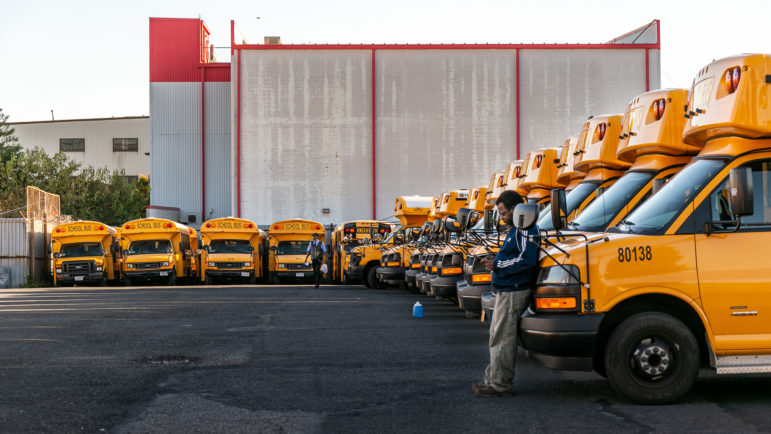When it came time to send his son to high school four years ago, Alex Gutmacher wanted to send Michael, then 13, to one of the city’s small schools, where he could focus on his talents in writing poetry and playing the guitar and banjo.
Gutmacher, a Ukrainian immigrant, believed that small schools, public institutions that limit the number of students to 500 and specialize in particular fields, would give Michael, who was new to English, the added attention he needed to learn the language and hone his other abilities.
But once he started looking, Gutmacher, who lives in Midwood, Brooklyn, found that the nearest school with an English Language Learner program was in the Bronx.
“For children who are talented, this is my opinion, small schools are much better and very important for immigrant children,” said Gutmacher, 49, an entertainment producer who moved to the United States five years ago. “But I live in Brooklyn, so two hours on the train to the Bronx? No way.”
Instead, Michael, now 17, enrolled in a much larger high school nearby, with English language programs and classes for gifted artists. His parents are satisfied with the school, but would have preferred the more personalized setting, Gutmacher said.
The trouble Gutmacher encountered in looking for a small school reflects the findings of a new study, which found that such schools do not serve students learning English adequately. Although Mayor Bloomberg has recently created many more small schools, less than half of them provide English or bilingual classes, and those that do are overcrowded and unevenly distributed around the city, according to a report issued last week by the New York Immigration Coalition, Advocates for Children and six other immigrants’ advocacy organizations. The findings showed the shortcomings of small schools in serving immigrant children, who have the highest dropout rates in the city, advocates said.
“A lot of parents want their kids to be in small schools because they have less of a factory model and are more personalized and would put kids on career tracks,” said Chung-Wha Hong, executive director of the Immigration Coalition. “But there’s a lack of access.”
In a statement issued in response to the report, So Many Schools, So Few Options, the Department of Education praised the success small schools have had thus far in educating English language learners, called “ELL” students, and said it would review the study’s suggestions.
“For far too long ELL students in secondary schools, like many other students, did not get the choices and options they deserve,” said Andres Alonso, the department’s deputy chancellor of teaching and learning. “Our new small school initiative is changing those conditions across the city.”
Since 2002, the city has opened 197 small high schools. That brought the total to 235 – about two thirds of the city’s 371 public high schools. Bloomberg has pledged to create another 50 by 2009. The new institutions are allowed to take two years to set up their English as a Second Language classes before accepting those students, a provision the immigrant groups criticized. The study found that many older small high schools do not offer the classes, as well.
In theory, these schools, which educate about one-sixth of the city’s 311,000 high school students, should help immigrant children excel academically, advocates said.
According to the report, just over half of English learners drop out of high school, compared to 32 percent of all high schoolers. Overall, immigrant children in small schools average much higher promotion rates and slightly higher attendance records than those in all other schools. However, 93 of the 183 new schools questioned said that fewer than 5 percent of their students this year were English learners.
As a result, the schools that do provide for immigrants are overcrowded, according to advocates. They’re also unevenly dispersed, the report said. Queens, for instance, is home to 29 percent of the roughly 38,000 high school-age English learners in the city, but only has 7 percent of small schools.
“We long ago supported small schools, but we never envisioned them to be so selective,” said Noreen Connell, executive director of Educational Priorities Panel, which lobbies for the reform of city public schools, adding that there’s also a lack of programs for special education students. “It’s creating another tier in the many tiers we have. We’ve always been concerned about educational opportunities for these students, but there’s not much choice if the schools are selective.”
The report’s recommendations for the city include requiring schools to set up English language programs and training staff better; opening more small schools in heavily immigrant-populated communities; and, at the same time, making sure larger schools are not neglected. Hong said the groups want to work with the city to improve the situation.
In his statement, Deputy Chancellor Alonso said he planned to meet with the study’s authors. “We are committed to improving the education of ELL students, in small schools and elsewhere in our system,” he said.
Public high school graduate Min Yi Zhou, however, said she was not satisfied with the support she received in her last year of high school, when her large school was split into a group of small ones.
“I don’t feel that the small school was better than the large one,” said Zhou, 20, who immigrated from China five years ago. She graduated from Bayard Rustin High School for Humanities in the West Village last year, and is now studying math at Hunter College. “The ESL program did not help me improve my English. I couldn’t make friends with people who spoke English, only my Chinese friends.”









